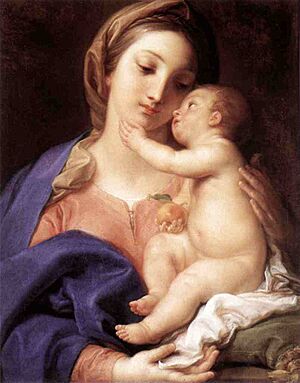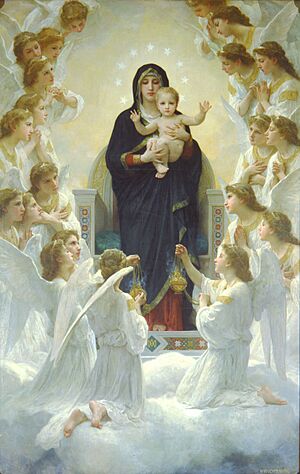Hail Mary facts for kids
The Hail Mary is a special Christian prayer. It is said to Mary, who is the mother of Jesus. Most of the prayer comes from the Gospel of Luke in the Bible. Some parts were added later, around the 13th century (the 1200s). When people say the Hail Mary, they are asking Mary to pray for them.
Many Christian groups use this prayer. The Roman Catholic Church uses it a lot. It is a very important part of the Rosary. The Eastern Orthodox and Oriental Orthodox Churches also use the prayer. Other groups like Anglicans and some Protestant churches use it too.
Contents
What the Bible Says About the Hail Mary
The Hail Mary prayer uses two important phrases from Saint Luke's Gospel.
The first phrase is "Hail, full of grace, the Lord is with thee, blessed art thou amongst women" (Luke 1:28). This means: "Be glad! You are full of God's special favor. God is with you. You are truly blessed."
The second phrase is "Blessed art thou amongst women and blessed is the fruit of thy womb" (Luke 1:42). This means: "You and your child, Jesus, are both blessed."
When the Hail Mary was first created, it was much shorter. In Western Europe, around the mid-1200s, the prayer was just a few words. The name "Mary" was added after "Hail." So, the prayer was "Hail Mary, full of grace." We know this from the writings of Saint Thomas Aquinas.
The first phrase from Saint Luke's Gospel is how the Angel Gabriel greeted Mary. This greeting was first written in Koine Greek. The Greek word for "Hail," chaíre, means "Rejoice" or "Be glad." This was a common greeting in ancient Greek.
The Hail Mary in Eastern Traditions
The Hail Mary prayer used by the Eastern Orthodox Church and Eastern Catholic Churches is a bit different. It is written in Greek:
- Theotokos Virgin, rejoice, Mary full of grace, the Lord is with you. Blessed are you among women, and blessed is the fruit of your womb, for you have borne the Saviour of our souls.
Another way to translate this into English is:
- Mother of God and Virgin, rejoice, Mary full of grace, the Lord is with thee. Blessed art thou amongst women, and blessed is the fruit of thy womb, for thou hast given birth to the Saviour of our souls.
"Theotokos" is a special title for Mary in the Eastern Churches. It is a Greek word that means "the one who gives birth to God."
The Hail Mary in Western Traditions
There are different ideas about when the Hail Mary became the version we know today. The Catholic Encyclopedia says that the prayer was not changed much until about the year 1050.
Saint Thomas Aquinas said that by the mid-1200s, Western churches had only added the word "Mary" to the Bible verses. Adding her name made it clear that the prayer was for Mary. Around the same time, the name "Jesus" was also added. This made it clear that Jesus was "the fruit of Mary's womb."
This means the Western version of the Hail Mary did not come from the Greek version. The Greek version has different words, like "for you have given birth to the Saviour of our souls," which were never in the Western version.
Before the 16th century, the Hail Mary mostly greeted and praised Mary. But during the 1500s, new words were added. These new words asked Mary for help. In 1555, a Dutch Jesuit named Peter Canisius added these words to his catechism: "Holy Mary, Mother of God, pray for us sinners."
By the time of the Council of Trent eleven years later, this sentence, and some new words, had been added to the Hail Mary. In 1566, the Catechism of the Council of Trent included this sentence: "Holy Mary, Mother of God, pray for us sinners now and at the hour of our death. Amen." This was the last change made to the Hail Mary.
In Latin, the prayer is:
- Avē Marīa, grātia plēna, Dominus tēcum. Benedicta tū in mulieribus, et benedictus frūctus ventris tuī, Iēsus.
- Sancta Marīa, Māter Deī, ōrā prō nōbīs peccātōribus, nunc et in hōrā mortis nostræ. Āmēn.
- Hail Mary, full of grace, the Lord is with thee; blessed art thou among women, and blessed is the fruit of thy womb, Jesus.
- Holy Mary, Mother of God, pray for us sinners, now and at the hour of our death. Amen.
The Hail Mary in Syriac Orthodox Tradition
The Syriac Orthodox Church uses a different version of the Hail Mary. This version is quite similar to the modern Western form.
In this prayer, a leader starts, and everyone else says the rest:
- Leader: Hail Mary, full of grace.
- People: Our Lord is with Thee. Blessed art Thou among women, and blessed is the fruit of Thy womb, our Lord, Jesus Christ. O Virgin Saint Mary, O Mother of God, pray for us sinners, now and at all times, and at the hour of our death. Amen.
How the Hail Mary is Used in Churches
Eastern Churches
In the Eastern Orthodox and Eastern Catholic Churches, the Hail Mary is very common. It is usually said in the Greek form or in translations of the Greek form. It might not be said as often as in the West, but it is well-known and used often. It is also sung three times at the end of Vespers during an All-Night Vigil. It is also part of many daily prayers.
Roman Catholic Church
The Hail Mary is the most important part of the Rosary. The Rosary is a special way of praying often used by Western Catholics.
When praying the Rosary, Catholics say ten Hail Marys in a row. Before each set of ten, they pray one Our Father. After the ten Hail Marys, they pray one 'Glory Be'. This set of prayers is called a "decade." Usually, Catholics say five decades when they pray the Rosary.
While praying each decade, Catholics think about different "Mysteries" of the Rosary. These Mysteries are about important events in Jesus' and Mary's lives. They include:
- Things that happened during Jesus' childhood (Joyful Mysteries)
- Jesus' public ministry (Luminous Mysteries)
- The Passion, including Jesus' crucifixion (Sorrowful Mysteries)
- Jesus' Resurrection and after (Glorious Mysteries)
The Hail Mary is also a key part of the Angelus. This is a prayer that many Catholics say three times every day. Some Anglicans and Lutherans also say the Angelus.
Anglican Use
Traditional Anglicans also use the Hail Mary. They use it in much the same way as Roman Catholics do. Both groups use the Rosary and say the Angelus. Anglican churches often have statues of the Virgin Mary.
Many Anglicans pray the Hail Mary. However, how it is used can be different in various areas. This is because the Catholic and Anglican Churches have some different beliefs.
Musical Versions of the Hail Mary
Many people have written music for the Hail Mary. It is also known by its Latin name, Ave Maria.
During the Renaissance
During the Renaissance period, many composers set the Hail Mary to music. Famous composers like Jacques Arcadelt, Josquin des Prez, Orlande de Lassus, and Giovanni da Palestrina wrote musical versions. However, at this time (before the Council of Trent), there were still different versions of the prayer. Because of this, some older Renaissance pieces have slightly different words than today's Hail Mary. For example, Josquin Desprez actually created more than one musical version of the Ave Maria.
Later Versions
One of the most famous musical versions of the prayer was created by Charles Gounod in 1859. He added a beautiful melody and words to Johann Sebastian Bach's first prelude (a short piece of music) from the Well-Tempered Clavier.
Other famous musical versions of the Hail Mary were written by:
- Antonín Dvořák in 1877
- Giuseppe Verdi, a famous opera composer, in 1887 (for his opera Otello)
- César Cui, a Russian composer. He wrote music for the Hail Mary at least three times.
- Famous composers including Wolfgang Amadeus Mozart, Byrd, Edward Elgar, Giuseppe Verdi, Camille Saint-Saëns, Gioachino Rossini, Johannes Brahms and Perosi.
- Famous Eastern European composers like Sergei Rachmaninoff, Igor Stravinsky, and Bortniansky also wrote musical versions of the Hail Mary in Slavonic.
In Protestantism
Protestant Christianity, like Catholicism, does not worship Mary. Some Protestants have used musical versions of the Ave Maria, but they changed the words. For example, Ave Redemptor uses the music of the Ave Maria, but it focuses on Jesus instead:
- Ave redemptor, Domine Jesus:
- Cujus ob opus
- Superatur mors, enim salvatio
- Nunc inundavit super universam terram.
- Sancte redemptor, reputata
- Fides est nobis peccatoribus,
- Nunc et in morte, ad iustitiam.
- ENGLISH TRANSLATION
- Hail the Redeemer, Lord Jesus,
- By whose work
- Death is defeated, for salvation
- Has now overflowed upon all of the world.
- Holy redeemer, our faith
- Is reckoned to us sinners,
- Now and in death, as righteousness.
Images for kids
-
The Annunciation by Fra Angelico, 1433–34
-
The beginning of the verse in decorated letters in a book of hours
-
The traditional Gregorian chant in square notation
See also
 In Spanish: Avemaría para niños
In Spanish: Avemaría para niños







